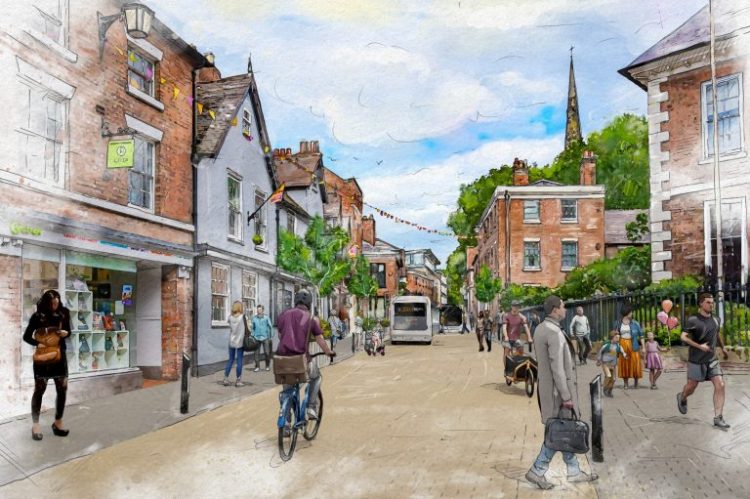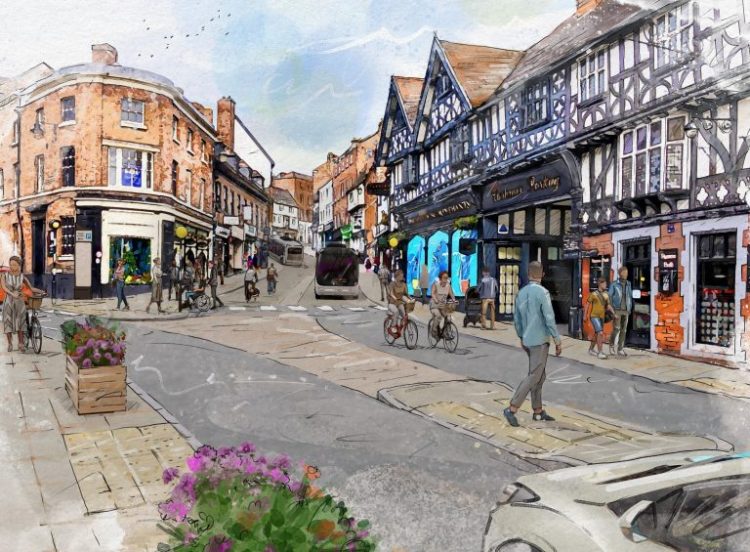Next steps set to be agreed for Shrewsbury movement strategy

How Dogpole could look under the plans
Councillors will next week consider the latest version of strategy that aims to improve how people move in and around Shrewsbury – and be asked to take the next steps towards its introduction.
The Shrewsbury Movement and Public Space Strategy is an ambitious 10-year strategy published by the Shrewsbury Big Town Plan Partnership, made up of Shropshire Council, Shrewsbury Town Council and Shrewsbury BID. An eight-week public consultation into the plans ran from 26 January 2024.
The strategy is designed to be implemented in phases, subject to further detailed surveys, assessments and traffic modelling and the availability of funding, It’s aligned to local, regional and national priorities.
Proposals include the introduction of traffic loops, meaning vehicles would not be able to drive straight through the town centre; giving more priority to buses, cyclists and pedestrians; and creating more ‘park and choose’ sites on the edge of the town centre.
The strategy has been updated to reflect the findings of the consultation, and at their meeting on 11 September Shropshire Council’s Cabinet will be asked to progress implementation of the strategy, including finalising a 10-year delivery plan, subject to securing funding.
From the responses to the consultation the Movement Strategy has identified and prioritised some key principles:
- Reduce/remove through traffic from the town centre.
- Provide an efficient public transport network with improved facilities in the town centre.
- Reduce vehicle speeds and volumes of private motor vehicles.
- Reallocate road space to provide space for business and event activity, pedestrians and cyclists.
- Improve cross-town connectivity by sustainable transport modes.
The next stage of work would include a series of feasibility and other work, looking at traffic modelling, the proposed traffic loops, parking and park and ride, freight delivery and rail travel.
Further engagement and consultation work specifically related to the 21 interventions within the strategy will continue into the implementation and delivery phases.

How Wyle Cop could look under the plans
Ian Nellins, Shropshire Council’s deputy Leader and member of the Shrewsbury Big Town Plan Partnership, said:
“The public consultation undertaken by the Partnership was extensive, and the residents of Shrewsbury were clear on the principles they wish to see adopted and implemented as demonstrated through the public consultation results – with the final version of the Movement Strategy amended to reflect the findings. The consultation has demonstrated there is significant, positive interest in the strategy from all sectors of the residential and business communities, as well as those across the county and the wider region. It’s also gaining interest from other local authorities due to its collaborative approach and high levels of public engagement responses.
“The importance of ongoing public consultation and engagement as the interventions are designed and developed was a key ask and we’ll ensure that we continue to seek the view of residents and businesses as work progresses.”
Seb Slater, executive director of Shrewsbury BID and member of the Shrewsbury Big Town Plan Partnership, said:
“The Movement Strategy sets out the vision, aspirations and a deliverable plan of actions and interventions to realise many of the opportunities that it highlights for Shrewsbury. It is vision-led with the goal of making Shrewsbury one of the most inclusive, accessible, and economically vibrant towns in the UK. To achieve this there must continue to be a transformational approach to rethinking movement and public space within Shrewsbury whilst recognising that that some of these interventions will require further scoping, technical assessment and traffic modelling in the locality, as well as detailed engagement with local businesses.”
Alan Mosley, Leader of Shrewsbury Town Council, and member of the Shrewsbury Big Town Plan Partnership, said:
“This is a major step forward. There is a clear statement of goals and recognition that coordination over a lengthy period of time will be absolutely vital. There is also recognition that full and meaningful consultation will be a prerequisite at each stage of implementation.
“The strategy has been written to be adaptable and flexible, yet with clear objectives, and any changes in the town will be managed sensitively and over a realistic period that allows interventions to be well developed, appraised and introduced, possibly through trials to minimise any concerns.”
Further information
- At their meeting Cabinet will be asked to recommend to full Council that the Shrewsbury Movement and Public Space Strategy (MPSS) be adopted as a material consideration in the planning decision-making process; and to delegate responsibility to the Executive Director of Place, in consultation with the Section 151 Officer, and the Portfolio Holder for Climate Change, Environment and Transport, to progress implementation of the MPSS, to include, but not limited to, finalising the 10-year delivery plan, subject to securing funding.
- The MPSS provides an overarching framework for projects and activities currently in delivery, in development and yet to be identified. It further ensures an integrated approach to related activities such as parking, park and ride provision, and rail and bus services.
- Whilst not considered a dependency to delivering the MPSS, the strategy is cognisant of the proposed North West Relief Road (NWRR) and the need for such highway infrastructure improvements to remove unnecessary through traffic from the town centre, which aligns with the key principles of the MPSS.
- The MPSS has been co-developed and funded by the Shrewsbury Big Town Plan (SBTP) Partnership and it will deliver key objectives of the Big Town Plan (BTP 2018) and the Masterplan Vision (2021). Specifically, the MPSS boldly sets the strategy for the BTP’s ‘Rethinking Movement’ and public space across Shrewsbury, providing a series of interdependent interventions that Shropshire Council, on behalf of the Big Town Partnership Movement Steering Group and wider stakeholders, will collectively develop and deliver through existing and proposed funding sources.

